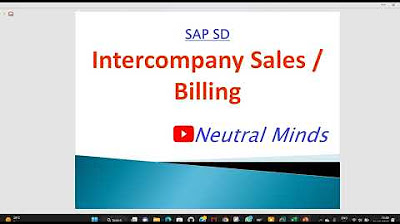Oracle Fusion Intercompany Transaction | Oracle Fusion Intercompany Elimination | Fusion BISP
Summary
TLDRThis video explains the concept of intercompany transactions in Oracle Fusion Financials, focusing on the Advanced Global Intercompany System (AGIS). The speaker walks through a business case where a head office purchases software licenses and shares the usage charges with subsidiaries. Two approaches to handling these transactions are discussed, highlighting issues such as disputes over debit notes and discrepancies in timing. The process is further illustrated with an example involving two legal entities sharing the same chart of accounts. The speaker demonstrates how transactions are processed, approved, and posted in the Oracle system, including the creation of journal entries and elimination entries.
Takeaways
- 😀 Intercompany transactions refer to activities conducted between affiliates or operating units of the same parent company.
- 😀 In the business case presented, a software license is bought at the head office level, and usage charges are passed to the subsidiary.
- 😀 The first approach to handling this transaction involves booking the expense, creating a liability, and adjusting intercompany accounts at month-end.
- 😀 The second approach directly books intercompany adjustments at the month-end, creating a debit note for the subsidiary.
- 😀 One key issue arises when the subsidiary disputes the debit note, requiring changes and re-processing of the transaction.
- 😀 Another problem occurs if the subsidiary does not record the expense in the same month, creating reconciliation challenges.
- 😀 Oracle Fusion’s Advanced Global Intercompany System (AGIS) is designed to streamline and resolve such issues.
- 😀 In the example, the U.S. legal entities (one and two) use the same chart of accounts with different balancing segment values for intercompany transactions.
- 😀 The process in Oracle Fusion starts by creating intercompany transactions between the two organizations, specifying the provider and receiver accounts.
- 😀 After creating the transaction, approval from the receiver legal entity is required before transferring the entry to the general ledger and posting journal entries.
- 😀 The final step involves creating intercompany elimination entries in the general ledger to reconcile and balance the intercompany transactions across different entities.
Q & A
What is the primary topic of the script?
-The primary topic of the script is intercompany transactions in Oracle Fusion Financials, specifically focusing on the Advanced Global Intercompany System (AGIS).
What does 'intercompany' mean in the context of this script?
-'Intercompany' refers to activities or transactions conducted between two or more affiliates or operating units of the same parent company.
Can you explain the first approach to handling intercompany transactions as discussed in the script?
-In the first approach, expenses are booked, and a liability is created when the invoice is booked. During the month-end process, accountants adjust intercompany accounts, passing the subsidiary debit and expenses credit, reducing expenses and booking receivables in intercompany accounts.
What challenges are encountered with the first approach to intercompany transactions?
-Challenges arise when a subsidiary disputes the debit note or fails to book the expenses in the same month. This can lead to intercompany reconciliation issues.
What does the second approach to intercompany transactions involve?
-In the second approach, the head office directly books the transaction to the intercompany account and raises a debit note at month-end, which is then adjusted against the subsidiary's account.
What issues are associated with the second approach?
-The main issue with the second approach is that if the subsidiary disputes the debit note, the head office has to make adjustments, which can lead to further complications and delays in the reconciliation process.
How does Oracle Fusion's AGIS module help in resolving these issues?
-Oracle Fusion’s AGIS module helps by automating intercompany transaction management, ensuring proper reconciliation and handling adjustments more effectively between the head office and subsidiaries.
What are the key steps involved in creating an intercompany transaction in Oracle Fusion?
-The key steps include navigating to the intercompany transaction task panel, selecting the transaction type (e.g., shared service), entering transaction details (provider, receiver, amounts), and submitting the transaction for approval before transferring it to the General Ledger.
What happens after the intercompany transaction is approved in Oracle Fusion?
-Once the transaction is approved, it is transferred to the General Ledger, where journal entries are created. The transaction is then posted for accounting purposes.
How are elimination entries handled in intercompany transactions in Oracle Fusion?
-Elimination entries are created to reconcile intercompany transactions and ensure that balances between related companies are correctly adjusted, typically performed during the period-end process to ensure accurate financial reporting.
Outlines

此内容仅限付费用户访问。 请升级后访问。
立即升级Mindmap

此内容仅限付费用户访问。 请升级后访问。
立即升级Keywords

此内容仅限付费用户访问。 请升级后访问。
立即升级Highlights

此内容仅限付费用户访问。 请升级后访问。
立即升级Transcripts

此内容仅限付费用户访问。 请升级后访问。
立即升级浏览更多相关视频

Transaksi Antar Perusahaan Afiliasi 2 - Penjualan / Pembelian Persediaan - Arus ke Bawah

Transaksi Antar Perusahaan Afiliasi 1 - Konsep Dasar - AKUNTANSI KEUANGAN LANJUTAN 2

Intercompany Transactions: Inventory Transactions. CPA Exam

Transaksi antar Perusahaan Afiliasi 3: Penjualan / Pembelian Persediaan Arus ke Atas

SAP SD Intercompany Sales / Billing process with Configuration

Transaksi Antar Perusahaan Afiliasi Penjualan Pembelian ASET TETAP
5.0 / 5 (0 votes)
